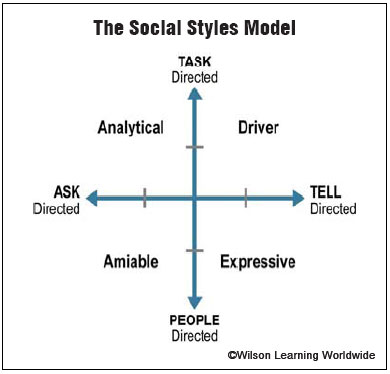Unless addressed, relationship tensions between colleagues will breed conflicts, misunderstandings and overall failures to communicate that weaken performance. Yet, there is a powerful tool available that can reduce these barriers to productivity - and therefore profitability. Versatility. Discover why 75% of employees may not relate to what you say - and what to do about it.
 Versatility: The answer to relationship tension and stress
Versatility: The answer to relationship tension and stress
Versatility is defined as the ability to understand differences in communication preferences and to adapt to make others more open and receptive - creating more effective and productive relationships. Versatility is a skill that can be learned, and people who have it, find it far easier to work together with others toward shared organisational goals.
To understand versatility and how it can affect relationships, consider people with whom you have regular contact. Do you know someone who is "too reserved" for your taste? Is there a manager or co-worker who seems to you to be "too emotional" or "too willing (or unwilling) to compromise"? Chances are, your reactions to these people are an indicator of differences in Social Style - how we habitually communicate and interact with others. When you find it easy to communicate and work with someone, there's a high probability you share the same social style. When your communication is difficult, it is often because of unrecognised social style differences.
 Social styles and the 75% problem
Social styles and the 75% problem
The social styles model on the right defines four primary communication styles - Driver, Expressive, Amiable and Analytical.
As the model shows, the four styles vary in terms of behaviours reflecting the dimensions of assertiveness (Tell) versus responsiveness (Ask) and People versus Task orientation. Drivers and Expressives tend to be more Tell oriented, while Amiables and Analyticals are more Ask oriented. Analyticals and Drivers are more Task oriented, while Amiables and Expressives are more People oriented. Because about 25% of people fall into each of these four categories, you likely share a social style with only about 25% of the people you meet. What are the consequences when we can't adapt to the other 75%?
Consider the communication challenges faced by a non-versatile manager who has a different social style than three-fourths of their employees. An Amiable employee will not be comfortable with a Driver manager who seems too focused on tasks and unconcerned with personal relationships. Analytical employees don't like to be told things they already know - but at the same time they don't want gaps in information a manager could have provided. These kinds of misalignments create the potential for friction, misunderstanding and lowered productivity.
Increasing versatility
For most of us, interpersonal behaviours and preferences are habitual and largely out of conscious awareness. Consider this scenario: a Driver, who has a more "tell" oriented style, may want to "cut to the chase" quickly. He may not even realise the source of his impatience with an Analytical who needs to ask more questions before taking action. As the situation progresses, the Driver may push harder for action while the Analytical employee goes into "back up" for her style - withdrawing and becoming less and less responsive.
Versatility comes with the recognition that people do have different styles and that each has unique strengths. Once people know their own style and understand style differences, they can learn how to modify behaviours to make it easier to work together in a way that is more effective for the whole team. When making decisions, managers can adapt to different expectations and needs based on their recognition of employees' styles. Expressives want managers to involve them in a decision when it affects the whole group, and Amiables like to have the group involved in brainstorming and problem solving. On the other hand, Analyticals are not as interested in group decision making and typically prefer to be involved only when decisions or actions affect them directly.
Key to improved business results
Companies can experience dramatic, measurable improvements in performance when their people learn how to adapt to others' social styles. In one study, building versatility skills yielded a 52% improvement in the ability to identify styles and recognise back-up behaviour - the "fall back" behaviour of each style when the individual is stressed. In the same organisation, 46% of employees reported a moderate to large improvement in work productivity. As one manager reported, "I've been more sensitive to my Driver / Driver style and the style of others during [coaching] sessions and as a result, I believe the sessions have been more productive and conversation / feedback has been freer flowing."
While there are many ways to improve communication in any given situation, the single most important factor for enhancing communication effectiveness across the board is versatility. As more leaders are required to take on greater responsibilities for more employees in today's business environment, and companies are fighting to retain customers and grow market share in the face of ever tougher competition, building this kind of capability provides a real competitive advantage for the individual and the company.